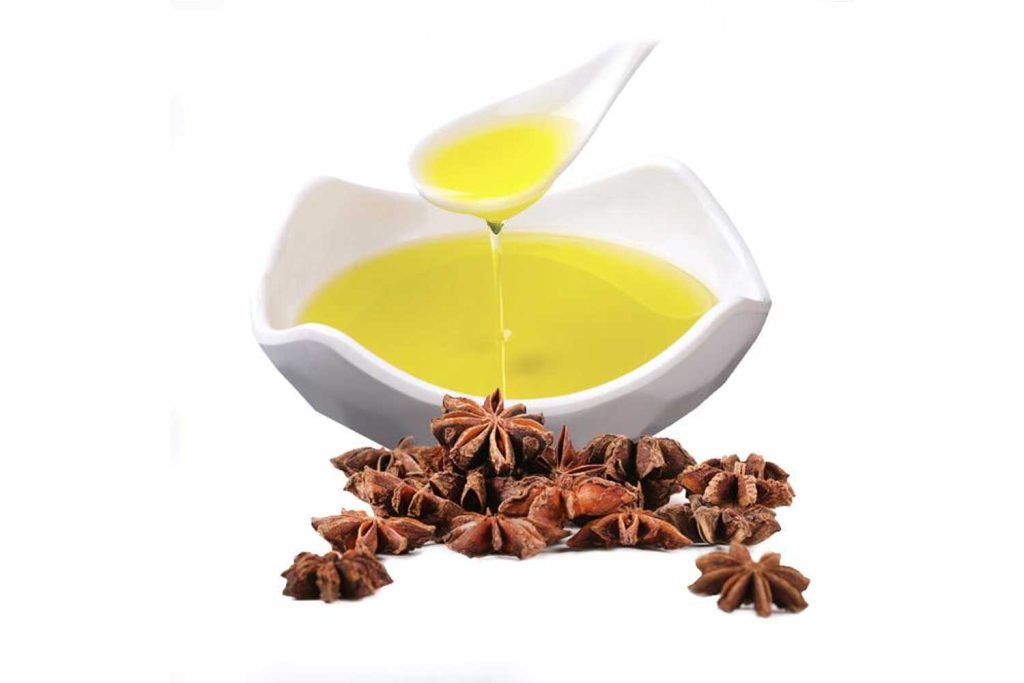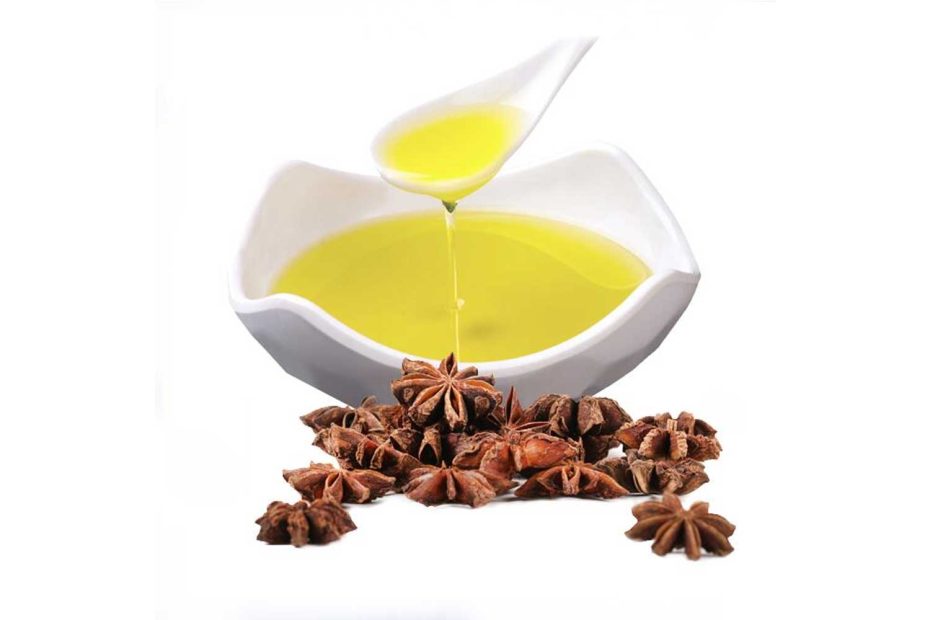What is Star Anise CO2 Oil?
Star anise (Illicium verum) is also known as sweet cumin. It belongs to the fennel and parsley family. Star Anise is an evergreen tree usually growing between 12-16ft, indigenous to Southeast Asia. The plant part used is the dried, ripe fruit that consists of around 8 seed bearing woody follicles attached to a central axis in the shape of a star, hence the name, Star Anise.
Anise CO2 Oil

The anise fruit is first dried and then star anise oil is extracted from anise seeds in a CO2 extraction process. The CO2 extraction method is used for extracting top grade star anise oil, the aroma of this star anise extract is fresher, brighter and more true-to-life than the steam distilled essential oil .
These aromatics are actually located in the star shaped seed walls of the fruit, not in the seeds themselves that are nestled within. In perfumery, star anise CO2 is perfect in culinary creations and in small notes can add a warm sweetness to amber accords.
This oil may also be helpful in aromatherapy blends that are intended to help digestion and muscular aches or pains. Very much popular in flavor industry for culinary use.
Purity
Optimum particle sizes can be obtained in the SCFE CO2 extraction method. In terms of product yield, saving energy and quality of product, this method is considered far better. Chemistry shared by star anise oil and anise oil is the same and hence star aniseed oil is used to substitute aniseed oil.
Star anise oil extracted by the SCFE Co2 method is hundred percent pure and natural. It has excellent therapeutic properties. Anise oil is a pale yellow and colorless oil is quite characteristic and smells like fennel. Principal constituents of the oil include anethole, methyl chavicol, anisic acid and aldehyde. The oil is falsified with caraway and fennel essential oils as well.
Valuable component
The most valuable component of star anise may lie within its dense supply of flavonoids and polyphenols. These may primarily be responsible for the spice’s broad applications and medicinal benefits
Some of the major health-promoting compounds found in star anise include:
- Linalool
- Quercetin
- Anethole
- Shikimic acid
- Gallic acid
- Limonene
Together, these compounds may contribute to the antioxidant, anti-inflammatory and antimicrobial properties of star anise.
Antibacterial Benefits
Another important medicinal benefit of star anise is its ability to inhibit bacterial growth implicated in a variety of common illnesses.
Some research has revealed that star anise extract is as effective as antibiotics against multiple drug-resistant pathogenic bacteria. This may be particularly useful for future development of new antibiotic medications .
Test-tube studies have also shown that bioactive compounds in star anise may be effective in treating urinary tract infections caused by different bacteria.
A separate study revealed star anise extract to be somewhat effective in reducing the growth of E. coli on a petri dish, though it wasn’t as effective as current, more common antibiotic treatments.
At this time, most research on the antibacterial properties of star anise is limited to animal and test-tube studies. More studies are needed to better understand how this spice may be used to support human health.
Health Benefits of Anise Essential Oil/What is Anise Essential Oil Good for?
In traditional Chinese and folk medicine practices, star anise is steeped in water to make a tea used to treat respiratory infections, nausea, constipation and other digestive issues. Star anise also makes a great addition to sweet dishes and desserts, such as baked fruit, pies, quick bread and muffins.
Star anise is rich in a variety of flavonoids and polyphenolic compounds that may contribute to its medicinal capacity.
May Have Anti-epileptic & Anti-hysteric Effect
Since anise essential oil may have a narcotic and sedative effect, it can calm down epileptic and hysteric attacks by slowing down circulation, respiration, and nervous response, if administered in higher dosages. This is contrary to its possibly stimulating and cordial properties, which are shown when administered in lower dosages. It might even be found effective in sedating nervous afflictions, hyper reactions, and convulsions as well. This property has been known and utilized for a very long time. However, this property should be used with caution, as heavy dosages can have adverse effects, particularly in children.
May Be Antirheumatic
This oil may provide relief from rheumatic and arthritic pains by stimulating blood circulation, and by reducing the sensation of pain in the affected areas.
May Help As An Antiseptic
This essential oil might also have antiseptic properties which may give wounds an effective protective layer against infections and sepsis resulting in faster healing of wounds.
May Be Used As An Antispasmodic
Spasms are an excessive contraction of the respiratory tracts, muscles, nerves, blood vessels, and internal organs that result in severe coughs, cramps, convulsions, obstructed blood circulations, aches in the stomach and chest and other symptoms. Situations or ailments caused by spasms are cramps, coughs, aches, diarrhea, nervous afflictions, and convulsions. The essential oil of anise, being a relaxant and an antispasmodic by nature, may help relax these contractions and give relief from the ailments mentioned above.
May Be A Good Aperient
This oil may have mild purgative properties but is safe to use. Unlike other synthetic or harsh purgatives, it may not be hard on the stomach and liver and does not leave you exhausted and fatigued. When taken in low dosages, it might help clear motions and cures constipation, resultant flatulence, and indigestion.
May Have Carminative Properties
Only those who are suffering from gas know what a relief it is to get rid of it. It is a very serious ailment and must be treated in a timely manner. It gives rise to indigestion, flatulence, acute chest pain, stomach aches, muscular cramps and pains, rheumatism in the long run, heaviness, hypertension, and even problems like hair loss and reduction of eyesight if it becomes chronic. Anise essential oil may promote the removal of gases. As a digestive, it may not allow gas to form, as indigestion is the cause of excess gas.
May Be A Potential Cordial
The potential warming effect of this oil on the respiratory and the circulatory systems may make it a cordial. This property might help counter colds, the deposition of phlegm, and problems like rheumatism and arthritis.
May Potentially Be A Decongestant
This oil of anise may be very effective in clearing congestion in the lungs and the respiratory tracts for conditions like asthma and bronchitis.
May Aid in Digestion
This property of anise and anise essential oil may be very commonly used to promote digestion. It has been an old practice to chew anise seeds, to serve desserts containing anise, or to have a glass of warm water with few drops of anise essential oil in it so that it may aid in digestion, especially after a heavy meal or a feast.
May Treat Respiratory Disorders
This oil may prove to be really remarkable as an expectorant and this property earned it an impressive reputation. It may loosen mucus or phlegm deposited in the lungs and respiratory tracts and may give relief from a cough, heaviness in the chest, breathing troubles, asthma, bronchitis, congestion, and other respiratory disorders. Due to the presence of this essential oil in the seeds, the seeds might be used for smoking to loosen catarrh or phlegm.
May Be A Potent Sedative
Due to its somewhat narcotic or numbing effects, it might be used as a sedative for anxiety, nervous afflictions, depression, anger, and stress as well as for symptoms such as insomnia due to its tranquilizing and relaxing effects. This effect is particularly visible when it may have been used in higher dosages since in very small doses, it acts as a stimulant. However, the utmost care should be taken while administering it in heavy doses, keeping in view its narcotic effects.
May Be A Good Vermifuge
This is yet another aspect of its insecticidal property. It may be a powerful agent to kill worms found in the intestines. This property can be particularly beneficial for children, as they are most commonly afflicted with intestinal worms.
Star Anise Oil Supercritical CO2 Extraction Machine

Star Anise, Aniseed and Fennel Essential Oils – what’s the difference?
Aniseed (or Anise)
Pimpinella anisum comes from the Umbellifrae (also called Apiacae) family, like fennel. It is very similar to fennel in its scent and has some similar molecules. The plant is also very similar to fennel too – with the flowers making “umbrels” in their innate design (hence the “Umbellifrae’ family). Fennel has more yellow flowers and aniseed flowers are white. The stories of aniseed and fennel both go back to ancient Rome and I love this quote from Botanical.com:
“Mustacae, a spiced cake of the Romans introduced at the end of a rich meal, to prevent indigestion, consisted of meal, with Anise, Cummin and other aromatics. Such a cake was sometimes brought in at the end of a marriage feast, and is, perhaps, the origin of our spiced wedding cake.”
It is high in anethole which represents the highly distinctive scent, and Salvatore Battaglia reports the typical analysis as:
- 85% trans-anethole (a possible dermal irritant)
- 2.29% cis-anethole
- 0.94% acetoanisole
- 0.58% anisaldehyde
- 0.58% safrole
- 0.18% linalool
- 0.17% a-pinene
- 0.07% camphene
- 0.01% B-pinene
Even throughout history this seed has been used for coughs, colds, digestive disorders and it’s used for the same thing today. It is said to a better expectorant than fennel too.
Fennel
Foeniculum vulgare essential oil comes from the seeds like the anise bush and as you can see they are very similar plants. One again the Romans used these seeds for digestion and the Greeks thought it a slimming herb because of its diuretic value. I definitely use fennel to release excess water and also watery emotions in my clients. I often use fennel with juniper and use this combo in clay masks for cellulite too. It seems to be a softer more nurturing oil than aniseed as it is lower in trans anethole. Here’s a typcial analysis from Salvatore Battaglia’s great book “The Complete Guide to Aromatherapy”:
- 64 – 69.2% trans-anethole
- 19 – 21.6% fenchone
- 3.9 – 6.5% methyl chavicol
- 1.8 – 3.3% a-pinene
- 1.2 – 1.7% limonene and 1,8 cineole
- 0.1 – 0.3% anisic aldehyde
- 0.5 – 0.8& myrcene
Fennel has slightly more uses as it can be used for cramps during menstruation and to help the flow of milk in lactating women. I use this oil energetically as a self nurturing oil as it’s warm and inviting scent can help you relax and release.
Star Anise
Illicium anisatum is part of the Schisandraceae family and you can see the little seeds within the star formations. Sometimes known as Japanese anise it is often mixed up with Chinese anise (Illicum verum) which is very similar. One of my suppliers offers Illicum verum var. Hooker only but I haven’t used it. In my practice I need to be able to use more commonly trialled and investigated oils and that’s why fennel is the optimization out of the three. Of course in perfumery it’s a different story as you would primarily selecting oils for their scent rather than therapeutic value. The closest I can find in a typical analysis is from “THE ESSENTIAL OIL OF ILLICIUM ANISATUM LINN. by W. B. Cook, A. S. Howard” and they state:
- 18.1% cineole
- 10.1% linalool
- 9.8% methyleugenol
- 6.8% α-terpenyl acetate
- 6.6% safrole
and a sesquiterpene hydrocarbon of unknown constitution (7.2%) and they say
“The composition of this oil differs widely from that of the commercially used star anise oil obtained from Illicium verum Hooker. The most striking difference between the two oils is found in the anethole content, which constitutes 88% of the commercial oil but only 1.2% of the oil here investigated.”
